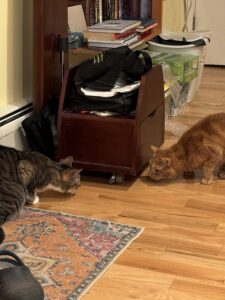My Jewish cultural heritage remains important to me despite not practicing the religion. Simple at-home rituals, like eating apples and honey with my mom-of-choice last night for Rosh Hashanah, add a sacred continuity to the life of our multi-faith household. After Hamas’ murderous attack and kidnapping of hostages on October 7, and the Israeli government’s violently disproportionate response that continues to kill thousands of Palestinian civilians with US-funded weapons, I’ve also felt responsible to reclaim Jewishness as a political identity. In an ideal world, I shouldn’t need an identity card to legitimize opposing the genocide in Gaza. But if being tangentially in the lineage of Holocaust survivors makes my protest more likely to be heard, I’m going to mention it in every email to Congress and the White House.
The High Holidays, which began last night (Oct. 2) with the Jewish New Year on the new moon, and conclude with Yom Kippur, the Day of Atonement, on the evening of Oct. 11, are a time for moral self-inventory and repentance. Tradition has it that this is when God decides whom to re-inscribe in the Book of Life for another year. I guess he knocked over his ink bottle in Israel-Palestine in 2023. Latest reports suggest that 64 hostages remain alive, out of the 251 taken by Hamas; the rest were either killed by their captors or by Israel’s own military actions. Meanwhile, Palestinian health authorities estimate that Israel’s war on Gaza has killed over 41,000 Palestinians since last October, the majority of them women and children.
I feel less safe as a person of Jewish origins in America since Israel started this war of “self-defense”. Rather than loosen their grip on Zionism, mainstream Jewish institutions are being seduced into alliance with the American Right, whose political candidates and pundits include actual Nazis. My local food co-op is debating whether to boycott Israeli hummus, which sounds to me like a Portlandia sketch.
In my opinion, a Jewish state should mean a place where it’s safe to be Jewish, not where it’s unsafe to be anything else. Making Palestinians live under apartheid is not congruent with the Jewish values of justice and mercy.
Here are some links that I found valuable for this period of mourning, reflection, and action.
At Vox Populi, an online journal of writing about social justice, Richard Hoffman has a new poem called “Mourning Gaza”, which begins:
And yet we think we can go on,
our earlier weeping this morning need not
bleed all over the day with its innocent and growing
receptivity to sunshine.
What does the naked soldier take off when he puts on that uniform?
What does the pale infant turning to dust
in the gray light deep in the powdery rubble know
of the torn hands of her parents digging to find her?
Nothing. Nothing is the answer.
And when the soldier takes off his uniform what does he find?
Nothing. Nothing is the answer. And it is the same nothing.
And what is it we put on when we dress for the day?
And how do we know
our tears will still be there when we come back for them?
What if they aren’t? What will wait for us instead?…
Alex Skopic, writing for Current Affairs, explains why we should all be concerned about Israel turning pagers into bombs in Syria and Lebanon:
Needless to say, Hezbollah has been linked to various acts of terrorism (successful or attempted) itself over the years. But even defending oneself against terrorists, as Israeli leaders would doubtless characterize their actions, cannot justify using terrorist tactics in return. (Perhaps Benjamin Netanyahu and Co. skipped “two wrongs don’t make a right” day in kindergarten. It would explain a lot.) Importantly, the New York Times notes that “the explosions had little strategic purpose,” as Israel is “hardly about to force Hezbollah’s leaders to give up a cause they have battled over for four decades” simply by blowing up pagers and walkie-talkies belonging to its rank-and-file members. Instead, writer David E. Sanger says that “the chief effect is psychological,” as this kind of attack “makes everyone fearful that ordinary devices can become an instant source of injury or death. It gnaws at the psyche.” In other words, it creates terror. It is terroristic in nature. Sangerdoesn’t call it that, opting for the word “sabotage” instead, but he does mention that “there is nothing new about sabotaging phones or planting bombs: Terrorists and spy agencies have done that for decades,” tacitly admitting that Israel’s actions are no different from those of prior “terrorists.”…
In fact, there are multiple international laws that specifically forbid what Israel has done. As Nikki McCann Ramirez points out for Rolling Stone, the Convention on Certain Conventional Weapons (not the catchiest name) bans “booby-traps or other devices in the form of apparently harmless portable objects which are specifically designed and constructed to contain explosive material.” That language is completely unambiguous. Pagers and walkie-talkies would both qualify as “apparently harmless portable objects,” and Israel is a party to the Convention. Likewise, Rule 80 of customary international humanitarian law, as recorded by the Red Cross, forbids “booby-traps associated with objects in normal civilian daily use” or “objects that are likely to attract civilians.”
In the wake of last spring’s campus protests, universities have largely responded by cracking down on students’ political expression, sometimes with life-altering consequences. “A Cornell Graduate Student Faces Deportation After Pro-Palestine Action,” Aaron Fernando at The Nation reported on Sept. 25.
Momodou Taal is a PhD candidate in Africana studies and a graduate student worker, attending Cornell under the F-1 visa program. In the last academic year, Taal joined student-led actions demanding that Cornell divest from industries complicit in Israel’s attacks on civilians in Gaza…
…On September 18, a group of students from multiple Cornell student groups under the umbrella organization Coalition for Mutual Liberation disrupted a career fair that was taking place at The Statler Hotel, which is located on campus grounds. The students disrupted this event because Boeing and L3Harris had tables at the fair—companies which, according to the students, are connected to the flow of military supplies being used by Israel to commit atrocities against civilians.
The university says that protesters forcibly entered the job fair by pushing campus police officers. Taal, who is a British national, was present at this action. When asked if the university had accused him of pushing police officers, Taal responded, “Yes, which is not true. I can say categorically that I shoved no police officer, nor did I not listen to a lawful directive, like they’re claiming.”
“They’ve identified who they think are leaders [of the pro-Palestine movement on campus], and therefore [they] are trying to make an example out of me.”
Now, Taal may need to leave the country because of his presence at the protest.
The F-1 visa program allows foreign nationals to reside in the United States if they are enrolled in an academic educational program, a language-training program, or a vocational program. Those with F-1 visas can also work on campus and in limited off-campus training positions. According to the Department of Homeland Security, suspension from an academic program is a valid reason for the termination of a record, which changes the immigration status of someone holding a F-1 visa…
…Jawuanna McAllister, of CGSU-UE’s bargaining committee…was unequivocal about the university’s singling out Taal, who appears to be the only student, among the more than 100 protesters at the September 18 action, to face suspension. “The university’s targeting of Taal, a Black, Muslim, international grad worker, is a calculated and shameful attempt to intimidate workers who are protesting the atrocities in Gaza and stifle free expression on campus,” said McAllister.
Rabbi Shaul Magid teaches Modern Judaism at Harvard University and is the author of The Necessity of Exile: Essays from a Distance (2023), a book on reconsidering Zionism. In this essay for Religion Dispatches, “Is ‘Western Self-Hatred’ the Problem in the Gaza War Protest Movement?”, Magid disputes the Orientalist lens through which Israel’s supporters view the pro-Palestine Left.
This isn’t to say that antisemitism plays no role today in the campus protest movement. It certainly does. The question is: what role? Antisemitism often latches onto different elements of the Left’s anti-Westernism—in this case the war on Gaza. This isn’t especially new. And while the Left has traditionally opposed antisemitism (one reason so many Jews in Eastern Europe and America were attracted to socialism in the early 20th century), it certainly also rears its head in Leftist circles. Everyone from Max Horkheimer to Hannah Arendt to Jurgen Habermas claim in different ways that it was the Enlightenment that gave us modern antisemitism.
In this case, however, the “eternal antisemitism” argument, and the argument that anti-Israelism is anti-Westernism, are self-serving and to my mind unsustainable. Let’s not forget, women and children are dying, innocent people are starving, and children are drinking from puddles because (in “self-defense”?) the IDF bombed water purification plants. Gaza has been obliterated, the devastation arguably one of the worst since World War II. Those are incontestable facts, reported by reputable news and relief agencies. What’s happening in Gaza may or may not in the end be understood as genocide (I do not think it is), but it’s clearly sociocide, the intentional destruction of a society including infrastructure (schools, hospitals, universities), resources (water, electricity), and services (garbage collection etc.). To claim that protests against decimation like this are primarily about “anti-Westernism” and not starving children is as I see it no better than blaming eternal antisemitism…
…Not surprisingly, Palestine solidarity was at the very center of this spring’s graduation ceremony at Harvard Divinity School (where I teach). There were calls for Harvard to divest from military arms, mixed with calls for a “free Palestine” (though I heard no chants of “from the river to the sea” and there was no mention of Hamas). Keffiyehs were ubiquitous. And yet a student who’s suing the university for antisemitism and an outspoken critic of the campus protests was duly applauded by his classmates as he rose to receive his diploma.
So what was really happening at the graduation? I submit, this wasn’t only about Israel/Palestine, or the war—though it was certainly also about that. This was about what one graduate called a referendum to end “carceral states.” Claiming Gaza is a “carceral state” may not be quite right, but it’s also not unreasonable. The term usually refers to the expanded and unequal criminal system in the US functioning through the dehumanization of people of color. To many, the people of Gaza and the West Bank have come to represent “carceral states” globally. And if Israel weren’t the ruling power embodying that “carceral state” I think many of the same Jews who today deplore the protesters would be with them. Think of significant Jewish opposition to China’s treatment of the Uyghurs or Jewish support for civil rights and the boycott of apartheid South Africa in the 1980s.
So, yes, the Palestinian Solidarity Movement is the latest symbol of the Left’s ongoing critique of the West, in the tradition of its support for abolition, women’s suffrage, civil rights, an end to the fighting in Vietnam, the dismantling of Apartheid, and BLM. It’s not a movement principally in support of Hamas or of October 7.*
It’s a sad irony that the State of Israel was founded as a state of the oppressed and has now become a state of the oppressor. As a Jew, and an Israeli citizen, that is painful to me as it is to many of us. But that doesn’t make it untrue. History is nothing if not a deep pool of irony where the unexpected often becomes the law. It’s not antisemitic to oppose those who dominate others, or to resist those who claim that they are the real victims of those they dominate.
Literary journal Tin House offers a podcast, Between the Covers, hosted by David Naimon. This transcript of his interview with British-Palestinian author Isabella Hammad, author of Recognizing the Stranger: On Palestine and Narrative, is a worthwhile longread, or you can listen to the audio on their website. (Hat tip to Jessica Dore’s Tarot Substack, Offerings, for the link.) I won’t even attempt to summarize all the ground that this conversation covers. Here are some quotes that stood out for me, mainly about the impossibility and necessity of making art when unspeakable things are happening.
But the significance is huge for everybody on the planet. The fact that a population can be so disposable is terrifying. To me, it’s very linked with the ways in which we’re destroying the planet as well. It’s this kind of savage removal of any boundaries or any pretenses or the pretenses have been worn away. That’s really frightening and should frighten people very seriously for themselves.
****
I don’t know if this is inherent to the novel form, if the novel is inherently tied to its bourgeois aesthetic origins if it’s hard to unshackle from that. I don’t think that’s true because there are lots of novels that are politically committed that do engage with struggle in direct ways and are galvanizing as well. I think that we shouldn’t close down how readers respond to texts. We can’t actually control how they read novels, how they respond to them, what they take from them. That wildness and that uncontrollability is part of their power and it’s part of what’s magic about novels. It’s a category error to suggest that the novel is going to itself, someone’s going to read a novel and then go into the street and march, but it can be part of a developing political education that allows them to take action. I think that it’s not so clear, but I won’t lie that that fear that revolutionary fervor is sapped by the well-being feeling that comes after watching something or reading something terrible, it is a counter-revolutionary emotion. But another counterargument is that it’s very tiring to fight the fight. We’re all exhausted at the moment. I mean, I’m exhausted and I know everybody’s exhausted. You can’t expect us to remain at that high tenor all the time. It’s a kind of multifarious process that requires also contemplation, it requires also moments of calm. They all feed each other in different ways.
****
What Palestinians have done for a very long time to try to prove that they are human, to humanize themselves, to write stories that humanize Palestinians. I think it’s insane to me that human beings should constantly have to humanize themselves. I mean, it’s not on us to prove that Palestinians are humans. It’s up to the other to overhear. I think that purely rhetorically, live aside the ethics of a politics of persuasion, but rhetorically, it’s much more effective to overhear than to feel like someone is trying to persuade you. It’s actually much more effective to hear dialogue, to hear different points of view, and to develop your understanding that way.
****
I was just saying the other day to somebody, “I just don’t feel any optimism anymore, there were points at which I felt really like we were going to see liberation in our lifetimes, that the uprising had set something in motion,” and the person I was speaking to said that on a macro level, they remain optimistic that the genie’s out of the bottle. Popular opinion has changed so dramatically, not at the higher echelons, but there’s no going back from this because everyone has seen it. That is no small thing. It’s hard to cling to that when so many people are being killed on a daily basis to feel that any such slaughter is worth it. But something’s happened and something’s changed. I think we have to have some faith in that, however long it takes that we’re on our way. As for advice about how to have faith in language, I mean there are people who are speaking, there are people who are speaking and writing and I think you just have to keep going basically.
Check out the Jewish Voice for Peace resource guide to the High Holidays for virtual and in-person services at synagogues around the U.S. that “have self-identified as non or anti-Zionist in their orientation as a congregation and/or in their practice. This means that it is absolutely understood that all people are equally valued: No nation state prayers are practiced, no Israeli flag is present, and a public statement calling for a permanent ceasefire is a baseline for all.”


